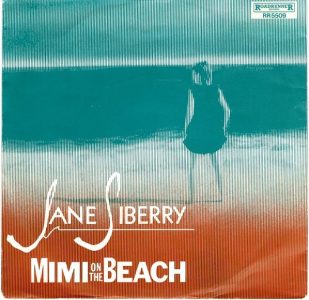#161: Mimi On The Beach by Jane Siberry
City: Ottawa, ON
Radio Station: CFRA
Peak Month: September 1985
Peak Position in Ottawa ~ #9
Peak position in Vancouver ~ did not chart
Peak Position on Billboard Hot 100 ~ did not chart
YouTube: “Mimi On The Beach”
Lyrics: “Mimi On The Beach”
Jane Siberry was born in 1955 in Toronto as Jane Stewart. She would take her subsequent surname, “Siberry”, from the family name of her maternal aunt and uncle. Many years later, she would explain this choice by stating “this woman and her husband were the first couple I met where I could feel the love between them and I held that in front of me as a reference point.” Siberry learned piano from the age of four, predominantly teaching herself and developing her own concepts of notation and structure. At school she learned conventional music theory (as well as French horn) and taught herself to play guitar by working through Leonard Cohen songs. In the mid-70s she was performing in folk clubs in Guelph (ON) as part of the folk group Java Jive.
She released her self-titled Jane Siberry album in 1981. Her followup to this folk album was an electro-pop recording in 1984 titled No Borders Here, with all tracks written by the musician. The lead single from the album was “Mimi On The Beach”.

“Mimi on the Beach” is a complex and introspective song that explores themes of isolation, societal expectations, and the fleeting nature of beauty and youth. The lyrics vividly depict a scene at the beach, where the narrator observes the people around them, particularly a girl named Mimi on a pink surfboard. Through this beach setting and the characters present, the song explores deeper emotions and contemplations.
An article on Liveboldandbloom.com details 17 signs that you are in a superficial relationship. These include:
- Your relationship is based on physical attraction
- You don’t know much about each other
- You don’t talk about anything important
- There are a lot of lies and half-truths
- You don’t have any shared interests or hobbies
- You keep your options open, hoping someone better will come along
- You get bored easily
- You don’t argue or fight
- Your partner is not your top priority
- You’re not planning a future with them

The repeated phrase “I scan the horizon for you, Mimi” conveys a sense of desire and anticipation. On the one hand, Mimi seems to represent an ideal or an unattainable goal. On the other hand, she seems preoccupied with her beauty and attention-getting antics by using her surfboard for a prop so people can look at her from a distance. This desire is contrasted by the narrator’s study of other beachgoers who are to be caught up in superficial quests, including teasing others (for example for being skinny), or a “girl with perfect teeth (who) picks up guys in lonely bars.” The contrast between the narrator’s introspection and the frivolous behavior of those around them highlights a sense of detachment or estrangement from her peers.
In “8 Signs You’re Becoming Detached From Others…” Jeanette Brown offers these descriptors to look for:
- Decreased interest in social activities
- Changes in communication patterns
- Growing preference for solitude
- Emotional numbness toward others
- Reluctance to share personal thoughts and feelings
- Prioritizing others’ needs over your own
- Diminishing interest in personal hobbies or activities
- Feeling misunderstood or out of place
Is Mimi (alone on her surfboard) or the song’s narrator (standing apart on the beach) feeling detached or alienated from the crowd?
The depiction of Mimi on the pink surfboard, with her picnic lunch and parasol, is exemplifies the fleeting state of youth and beauty. Mimi is a momentary vision of perfection against the backdrop of the beach, a place where people go to escape reality and decompress. The narrator’s desire for Mimi to paddle out to sea and face them suggests a desire for a deeper connection or understanding. These lines in the lyrics speak of a yearning for authenticity in a world that often seems shallow.
In a second bridge after the third verse, the lyrics predict that a “great leveler,” who eventually strip away all that is facile, and reduce everything to a plane with an expanding horizon. “You may never get a chance to explain yourself. And he’s going to take those mountains and shove them into valleys.” In the Bible, in the Book of Habukuk 3:6 it is written, “When he stops, the earth shakes. When he looks, the nations tremble. He shatters the everlasting mountains and levels the eternal hills.” And in Isaiah 40:4 it is written, “Fill in the valleys, and level the mountains and hills. Straighten the curves, and smooth out the rough places.” A takeaway from these Biblical verses is that the Creator (God, The Lord…) is also one who rearranges creation, and who destroys and upends it through earthquakes and more. In addition, the leveling involves the low places (valleys, gulches) being elevated, while the high places (mountains, hills) are humbled, brought down. By extension, the young and beautiful may be brought down while the aged and homely will be given recognition.
The encounter with “the great leveler” can be a symbol for the inevitability of aging, mortality, or coming to terms with the true self; Including an encounter with God, the Creator. “Mimi On The Beach” raises questions about whether facing this “great leveler” is a form of liberation or a fearful end. It adds a layer of existential contemplation to the story.
The narrator predicts that Mimi is going to “float…on the flat Sargasso Sea of your soul.” The Sargasso Sea is the only sea in the world without land boundaries. It is distinguished from other parts of the Atlantic Ocean by its characteristic brown Sargassum seaweed and often calm blue water. This floating cover of seaweed grows so thick that early Spanish crews feared their wooden caravels would halt and “never again feel a breath of wind,” as Christopher Columbus wrote in 1492. Both Sargassum and Sargasso originate from the Portuguese word “sargaço” meaning grape. The seaweed was named by 15th century Portuguese explorers who thought the air bladders of the Sargassum looked like the fruit.
The ocean water in the Sargasso Sea is distinctive for its deep blue color and exceptional clarity, with underwater visibility of up to 200 feet. “Mimi On The Beach” was a track from the album No Borders Here, a reference to the Sargasso Sea which had no land boundaries. The album’s cover graphic depicts a scene of the narrator in “Mimi On The Beach” looking from the beach onto the vast horizon.
The Sargasso Sea is bounded on the west by the Gulf Stream, on the north by the North Atlantic Current, on the east by the Canary Current, and on the south by the North Atlantic Equatorial Current, the four together forming a clockwise-circulating system of ocean currents termed the North Atlantic Gyre. The Sargasso Sea is 590 miles east of Florida, and includes the Bermuda Triangle. Bermuda is the only island in the Sargasso Sea.
Catalan cartographer Gabriel de Vallseca created Portolan (nautical) charts in the 1430s based on discoveries of the Azores and the expanse of the Atlantic Ocean to the west. These included the what became known as the Sargasso Sea.

1439 Portolan chart by Gabriel de Vallseca (Museu Maritim, Barcelona)
The “Sargasso Sea of your soul,” would mirror this Atlantic Ocean sea without land boundaries, which offers underwater visibility up to 200 feet. Such an interior landscape would offer an ability for deep reflection into oneself.
With all this floating around on her pink surfboard, with a picnic lunch and parasol, and checking out her arms and legs to admire her own beauty, the narrator of the song implores Mimi to stand up on her surfboard. After all, since she’s on a surfboard, why not proceed to use the surfboard for surfing instead of a prop to be seen by others on the beach. On the Gathering Waves website, Haley writes about “34 Surfing Tips for Beginners I wish Someone Told Me!” These include:
- Be sure you’re using the proper equipment (Mimi doesn’t have any proper equipment on her surf board)
- Make sure your leash is on the proper ankle (Mimi doesn’t have a leash on her ankle)
- Lay on the right spot of your board while paddling (Mimi isn’t paddling)
- Find a surfing buddy (Mimi has no surfing buddy)
- Have patience with yourself and don’t compare your progress to others (Mimi isn’t making any progress, at least on the surfing front)
“Mimi On The Beach” peaked at #4 in Boston, and #9 in Ottawa. The single stalled at #68 on the RPM Top 100 Pop Singles chart in Canada.
In 1985, Siberry released The Speckless Sky which reached #17 on the RPM Top 100 Album chart in Canada. It included “One More Colour”. The single climbed to #25 on the RPM chart in Canada. In 1990, her track “Something About Trains” was a nominee for Best Original Song at the Genie Awards. The song was part of the soundtrack for the film The Top Of His Head. In 1993, from her When I Was A Boy album came “Calling All Angels”. The track was included in the 1991 film Until the end of the World. Later it appeared as the film credits rolled at the end of the 2000 romantic film Pay It Forward.
From 2006 to 2009, Jane Siberry recorded under the name Issa. Early in 2006, Siberry closed her Sheeba office, then auctioned and sold nearly all of her possessions via eBay– including her Toronto home and her musical instruments. She retained one travelling guitar, but none of the other instruments featured on her albums and in her concerts. In 2006, she told The Globe and Mail that she had kept a very few precious possessions, including her Miles Davis CDs, in storage.
Later she would describe the process of choosing a new identity in terms of changing her writing approach – “Moving into Issa, I didn’t know if I’d be in the music business any more. I just started writing. I wanted to let go of any expectations and just try to get closer to what I heard in my head… I just tried to write as precisely as I could to what I heard in my head. I slowed everything down and took one note at a time, and just waited until I heard the next note.”
She talked about her recent adventures in decommodifying her life, her change in name, and her new conception of herself as an artist. Over 2006 and 2007, she documented the process of recording some thirty new songs in her journal, posted on her MySpace page and on her new website. She released two albums under the name Issa.
In 2009, Jane Siberry told the press “I felt the need to make some strong changes in my life. It seemed important to change my name, so I did. I changed it to a name that I thought was simple, an empty cup. I had never heard the name Issa before, and it turns out to have some wonderful meanings, including a haiku poet in Japan, and the name that Jesus had in India. But two weeks ago I officially changed my name back to Jane Siberry. I felt with the name change, I had gotten in my own way, in terms of devoting myself to my career, making my work available to people. So, Jane Siberry is my name again until further notice, but I feel richer from having been Issa for three years.”
In 2016 she released her 16th studio album titled Angels Bend Closer.
August 25, 2025
Ray McGinnis
References:
Dave Lefkowitz, “Dave’s Gone By Interview audio: Jane Siberry,” Dave’s Gone By, January 13, 2008,
“Jane Siberry: Open Hearts,” CKUA, October 14, 2024.
Haley, “34 Surfing Tips for Beginners I Wish Someone Told Me!,” Gatheringwaves.com, June 7, 2023.
Barrie Davenport, “What Are Superficial Relationships? 17 Signs You May Be In One or More,” Liveboldandbloom.com, November 3, 2023.
Eric Ralls, “Earth has one sea that touches no land, because it has no shore,” Earth.com, May 25, 2025.
Jeanette Brown, “8 signs you’re becoming detached from others, psychology explains,” Jeanettebrown.net, May 16, 2024.

CFRA 580-AM Ottawa Top Ten | September 21, 1984

Leave a Reply